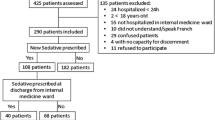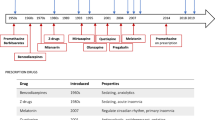Abstract
Purpose
This study investigated prescriptions for sedative–hypnotics via data obtained from the Health Insurance Review and Assessment (HIRA) service.
Methods
Data on sedative–hypnotic prescriptions from the HIRA service of the Republic of Korea were analyzed from 2011 to 2015. We included prescriptions for subjects > 18 years of age from hospitals and community healthcare centers. In addition, subgroup analyses with a subsample restricted to prescriptions from patients with diagnostic codes F510 (nonorganic insomnia) or G470 (insomnia) were performed. After analyzing the number of prescriptions by individual pharmacy items, the prescription codes were grouped as: (1) benzodiazepines; (2) non-benzodiazepines, including zolpidem; (3) antidepressants; and (4) antipsychotics. We calculated the monthly percent change in the number of prescriptions by drug group using Joinpoint regression.
Results
Among the sedative–hypnotic groups, benzodiazepines were the most commonly prescribed drugs in Korea during the study period. As a single sedative–hypnotic item, zolpidem was the most frequently prescribed medication for patients with insomnia. Prescriptions for all groups of sedative–hypnotics increased significantly during the study period. When stratified by age group, antipsychotic prescriptions increased significantly by 0.19–0.21% per month among men and women aged 50–59 years and > 70 years. Prescriptions for antidepressants in 30–39-year-old men increased significantly by 0.20%.
Conclusions
Benzodiazepine prescriptions as well as those for antipsychotics and antidepressants to treat insomnia increased during 2011–2015 in Korea. Monitoring the use of sedative–hypnotics at the national level is necessary, especially in the elderly population.


Similar content being viewed by others
References
Thorpy MJ (2012) Classification of sleep disorders. Neurotherapeutics 9:687–701. https://doi.org/10.1007/s13311-012-0145-6
Walsh JK, Coulouvrat C, Hajak G et al (2011) Nighttime insomnia symptoms and perceived health in the America Insomnia Survey (AIS). Sleep 34:997–1011. https://doi.org/10.5665/SLEEP.1150
Morphy H, Dunn KM, Lewis M, Boardman HF, Croft PR (2007) Epidemiology of insomnia: a longitudinal study in a UK population. Sleep 30:274–280
Cho YW, Shin WC, Yun CH, Hong SB, Kim J, Earley CJ (2009) Epidemiology of insomnia in Korean adults: prevalence and associated factors. J Clin Neurol 5:20–23. https://doi.org/10.3988/jcn.2009.5.1.20
McCall WV1, Reboussin BA, Cohen W (2000) Subjective measurement of insomnia and quality of life in depressed inpatients. J Sleep Res 9:43–48
Daley M, Morin CM, LeBlanc M et al (2009) Insomnia and its relationship to healthcare utilization, work absenteeism, productivity, and accidents. Sleep Med 10:427–438. https://doi.org/10.1016/j.sleep.2008.04.005
Sivertsen B, Øverland S, Pallesen S et al (2009) Insomnia and long sleep duration are risk factors for later work disability. The Hordaland Health Study. J Sleep Res 18:122–128. https://doi.org/10.1111/j.1365-2869.2008.00697.x
Schutte-Rodin S, Broch L, Buysse D, Dorsey C, Sateia M (2008) Clinical guideline for the evaluation and management of chronic insomnia in adults. J Clin Sleep Med 4:487–504
Kripke DF, Langer RD, Kline LE (2012) Hypnotics’ association with mortality or cancer: a matched cohort study. BMJ Open 2:e000850. https://doi.org/10.1136/bmjopen-2012-000850
de Gage SB, Moride Y, Ducruet T et al (2014) Benzodiazepine use and risk of Alzheimer’s disease: case–control study. BMJ 349:g5205. https://doi.org/10.1136/bmj.g5205
Chen PL, Lee WJ, Sun WZ, Oyang YJ, Fuh JL (2012) Risk of dementia in patients with insomnia and long-term use of hypnotics: a population-based retrospective cohort study. PLoS One 7:e49113. https://doi.org/10.1371/journal.pone.0049113
Chung KH, Li CY, Kuo SY, Sithole T, Liu WW, Chung MH (2015) Risk of psychiatric disorders in patients with chronic insomnia and sedative–hypnotic prescription: a nationwide population-based follow-up study. J Clin Sleep Med 11:543–551. https://doi.org/10.5664/jcsm.4700
Kim B, Ahn JH, Cha B et al (2015) Characteristics of methods of suicide attempts in Korea: Korea National Suicide Survey (KNSS). J Affect Disord 188:218–225. https://doi.org/10.1016/j.jad.2015.08.050
OECD Health Statistics (2015) https://doi.org/10.1787/health-data-en. Accessed 10 Dec 17
Sung-Hee OH et al (2014) In-depth investigation for prescribing trends of benzodiazepines in South Korea. Int J Clin Pharmacol Ther 52:460–470. https://doi.org/10.5414/CP202008
Kronholm E, Markkula J, Virta LJ (2012) What is behind the seeming cessation of the increase in sleep medicine consumption in Finland during the last years. J Public Health Res 1:149–154. https://doi.org/10.4081/jphr.2012.e23
Ford ES, Wheaton AG, Cunningham TJ, Giles WH, Chapman DP, Croft JB (2014) Trends in outpatient visits for insomnia, sleep apnea, and prescriptions for sleep medications among US adults: findings from the National Ambulatory Medical Care Survey 1999–2010. Sleep 37:1283–1293. https://doi.org/10.5665/sleep.3914
Mong JA, Baker FC, Mahoney MM et al (2011) Sleep, rhythms, and the endocrine brain: influence of sex and gonadal hormones. J Neurosci 31:16107–16116. https://doi.org/10.1523/JNEUROSCI.4175-11.2011
Glass J, Lanctôt KL, Herrmann N, Sproule BA, Busto UE (2005) Sedative hypnotics in older people with insomnia: meta-analysis of risks and benefits. Br Med J 331(7526):1169. https://doi.org/10.1136/bmj.38623.768588.47
Kim L, Kim JA, Kim S (2014) A guide for the utilization of health insurance review and assessment service national patient samples. Epidemiol Health 30:36:e2014008. https://doi.org/10.4178/epih/e2014008
Korea Statistics Office (2017) http://kostat.go.kr. Accessed 10 Dec 17
Bertisch SM, Herzig SJ, Winkelman JW, Buettner C (2014) National use of prescription medications for insomnia: NHANES 1999–2010. Sleep 37:343–349. https://doi.org/10.5665/sleep.3410
Pillai V, Cheng P, Kalmbach DA, Roehrs T, Roth T, Drake CL (2016) Prevalence and predictors of prescription sleep aid use among individuals with DSM-5 insomnia: the role of hyperarousal. Sleep 39:825–832. https://doi.org/10.5665/sleep.5636
Hermes EDA, Sernyak M, Rosenheck R (2013) Use of second-generation antipsychotic agents for sleep and sedation: a provider survey. Sleep 36:597–600. https://doi.org/10.5665/sleep.2554
Kamphuis J, Taxis K, Schuiling-Veninga CC, Bruggeman R, Lancel M (2015) Off-label prescriptions of low-dose quetiapine and mirtazapine for insomnia in The Netherlands. J Clin Psychopharmacol 35:468–470. https://doi.org/10.1097/JCP.0000000000000338
Finnish Medical Society Duodecim and the Finnish Sleep Research Society working group (2008) Treatment of insomnia, current care guidelines. Duodecim 124:1782–1794
Ji KH, Kang MR (2017) Trends of public interest in sleep disorders: looking by internet searching volume. Sleep Med Res 8:62–67. https://doi.org/10.17241/smr.2017.00101
Acknowledgements
This study was supported by the research fund of the Mental Health Technology Development Project (Project No. HM15C1197).
Author information
Authors and Affiliations
Corresponding authors
Ethics declarations
Conflict of interest
On behalf of all of the authors, the corresponding author states that there are no conflicts of interest.
Electronic supplementary material
Below is the link to the electronic supplementary material.
Rights and permissions
About this article
Cite this article
Lee, M.H., Choi, JW., Lee, J. et al. Trends in prescriptions for sedative–hypnotics among Korean adults: a nationwide prescription database study for 2011–2015. Soc Psychiatry Psychiatr Epidemiol 54, 477–484 (2019). https://doi.org/10.1007/s00127-018-1615-x
Received:
Accepted:
Published:
Issue Date:
DOI: https://doi.org/10.1007/s00127-018-1615-x




